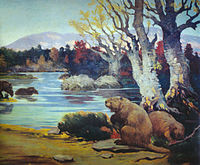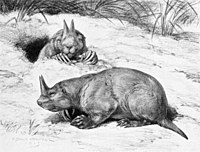This list is of rodent species that are extinct − no longer alive.
Species from related groups such as Lagomorpha (rabbits and hares) are not included.
Before 1500
Extinct after 1500
16th century
17th century
See also
References
^ a b Harington, C. R. (March 1996). "Giant beaver" . Yukon Beringia Interpretive Centre. Archived from the original on September 14, 2007. Retrieved 3 July 2014 . ^ Hopkins, Samantha S. B. (2005). "The evolution of fossoriality and the adaptive role of horns in the Mylagaulidae (Mammalia: Rodentia)" . Proceedings of the Royal Society B . 272 (1573): 1705– 1713. doi :10.1098/rspb.2005.3171 . PMC 1559849 PMID 16087426 . ^ Hooijer, D. A. (1957). "Three new giant prehistoric rats from Flores Lesser Sunda Islands" . Zoologische Mededelingen . 35 (21). Rijksmuseum van Natuurlijke Historie, Leiden: 299– 316. ^ Biknevicius, A. R.; McFarlane, Donald A.; MacPhee, R. D. E. (1993). "Body size in Amblyrhiza inundata (Rodentia: Caviomorpha), an extinct megafaunal rodent from the Anguilla Bank, West Indies: estimates and implications" (PDF) . American Museum Novitates (3079): 1– 26. ^ Petronio, C. (1970). "I roditori Pleistocenici della Grotta di Spinagallo (Siracusa)" (PDF) . Geol. Rom . IX : 149– 194. ^ Kurtén, Björn; Anderson, Elaine (1980). Pleistocene Mammals of North America . Columbia University Press. p. 274. ISBN 0-231-03733-3 ^ Rinderknecht, Andrés; Blanco, R. Ernesto (2008). "The largest fossil rodent" . Proceedings of the Royal Society B . 275 (1637): 923– 928. doi :10.1098/rspb.2007.1645 . PMC 2599941 PMID 18198140 . ^ a b c d e Millien, Virginie; Bovy, Helene (2010). "When teeth and bones disagree: Body mass estimation of a giant extinct rodent" . Journal of Mammalogy . 91 (1): 11– 18. doi :10.1644/08-mamm-a-347r1.1 JSTOR 27755167 . ^ Sánchez-Villagra, M. R.; Aguilera, O.; Horovitz, I. (2003). "The anatomy of the world's largest rodent". Science . 301 (5640): 1708– 10. doi :10.1126/science.1089332 . PMID 14500978 .


